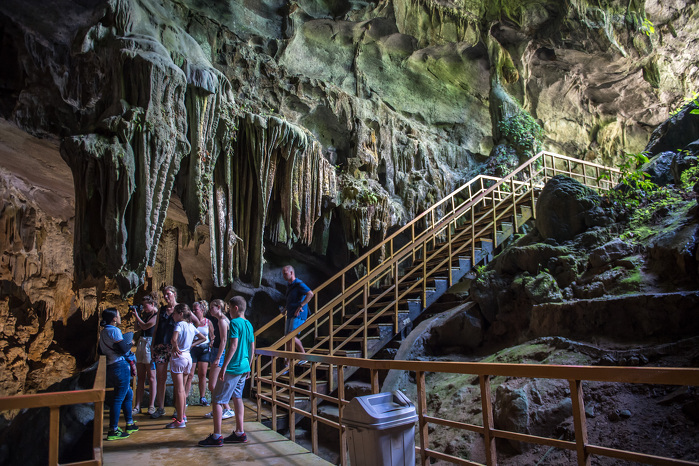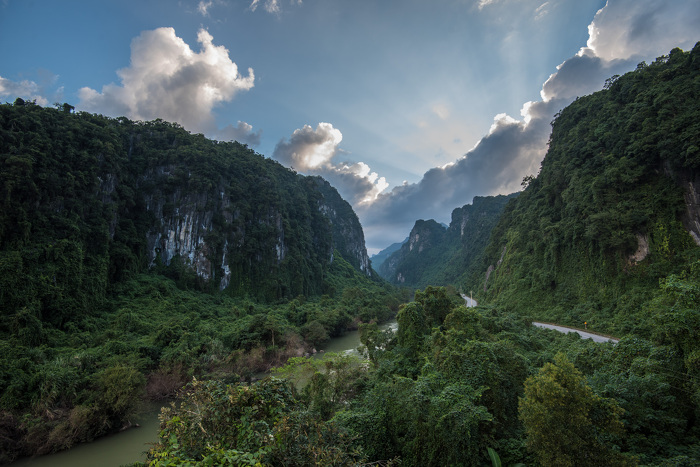Greater Mekong Subregion: Sustainable Tourism Development (ADF) (Loan - Viet Nam)
Details
|
Project |
38015-013 |
|
Related Projects |
Search |
|
Type |
Loan |
|
Sector |
Industry and Trade |
|
Country |
Viet Nam |
|
Start |
2008 |
|
End |
2015 |
|
Status |
Closed |
|
Last Edited |
05 Jul 2021 |
Project Description
The Greater Mekong Subregion (GMS) Sustainable Tourism Development Project was designed to benefit the poor in the Lao People-s Democratic Republic (Lao PDR) and Viet Nam by promoting environmentally and socially sustainable tourism. Its expected impact was the development of a sustainable, culturally and environmentally sound pro-poor tourism approach for the GMS, and the preservation of natural and cultural heritage. The expected outcome was sustainable tourism development that creates livelihood opportunities for the poor. Project areas included provinces with good tourism potential and that had poverty rates of up to 38.6%.
Progress
(as of March 2021)
Project closed
News and Multimedia

Improvement of walkways and lighting system in Tien Son cave, Son Trach commune, Bo Trach District, Quang Binh province was funded by ADBâs Greater Mekong Subregion Sustainable Tourism Development Project.
Source: ADB Flickr

Improvement of walkways and lighting system in Tien Son cave, Son Trach commune, Bo Trach District, Quang Binh province was funded by ADBâs Greater Mekong Subregion Sustainable Tourism Development Project.
Source: ADB Flickr

Boats transporting tourists going to Phong Nha. Training programs funded by the Greater Mekong Subregion Sustainable Tourism Development Project gave the local people opportunities to work in the tourism sector in and around the National Park.
Source: ADB Flickr

Blue boats transporting tourists going to Phong Nha. The wharf was funded by ADBâs Greater Mekong Subregion Sustainable Tourism Development Project. Training programs also gave the local people opportunities to work in the tourism sector in and around the National Park.
Source: ADB Flickr

Blue boats transporting tourists going to Phong Nha. The wharf was funded by ADBâs Greater Mekong Subregion Sustainable Tourism Development Project. Training programs also gave the local people opportunities to work in the tourism sector in and around the National Park.
Source: ADB Flickr

Blue boats transporting tourists going to Phong Nha. The wharf was funded by ADBâs Greater Mekong Subregion Sustainable Tourism Development Project. Training programs also gave the local people opportunities to work in the tourism sector in and around the National Park.
Source: ADB Flickr

Aerial view of Phong Nha-Kẻ Bà ng National Park in Quang Binh province. The area is noted for its system of caves and grotto systems with a total length of about 70 km, of which only 20 have been surveyed. 17 of these are located in the Phong Nha area and three in the Kẻ Bà ng area. Phong Nha holds several world cave records, as it has the longest underground river, as well as the largest caverns and passageways. Tourists mainly visit Phong Nha, Tien Son, Thiên ÄÆ°á»ng caves, Hang Ãn, and SÆ¡n Äoòng Cave.
Source: ADB Flickr

Aerial view of Phong Nha-Kẻ Bà ng National Park in Quang Binh province. The area is noted for its system of caves and grotto systems with a total length of about 70 km, of which only 20 have been surveyed. 17 of these are located in the Phong Nha area and three in the Kẻ Bà ng area. Phong Nha holds several world cave records, as it has the longest underground river, as well as the largest caverns and passageways. Tourists mainly visit Phong Nha, Tien Son, Thiên ÄÆ°á»ng caves, Hang Ãn, and SÆ¡n Äoòng Cave.
Source: ADB Flickr

Chay Lap Farmstay in Phuc Trach commune, Bo Trach District, Quang Binh Province. The community-based tourism area was first supported in 2001 by the GMS Sustainable Tourism Development Project funded by ADB. To enhance the efficiency and create more job opportunities, the People's Committee of Quang Binh province allowed it to partner with Oxalis Adventure Tours in order to upgrade the Farmstay to a four-star service.
Source: ADB Flickr

The Greater Mekong Subregion Sustainable Tourism Development Project are helping local people do business with tourists visiting the Phong Nha-Ke Bang National Park. Increased incomes derived from nature-discovery tours and adventures are improving the life of the local people in and around the National Park.
Source: ADB Flickr

The Greater Mekong Subregion Sustainable Tourism Development Project are helping local people do business with tourists visiting the Phong Nha-Ke Bang National Park. Increased incomes derived from nature-discovery tours and adventures are improving the life of the local people in and around the National Park.
Source: ADB Flickr

The Greater Mekong Subregion Sustainable Tourism Development Project are helping local people to do business in transporting tourists visiting Phong Nha caves. Increased incomes derived from nature-discovery tours are improving the life of the local people in and around the National Park.
Source: ADB Flickr

Improvement of walkways and lighting system in Tien Son cave, Son Trach commune, Bo Trach District, Quang Binh province by ADBâs Greater Mekong Subregion Sustainable Tourism Development Project.
Source: ADB Flickr

Improvement of walkways and lighting system in Tien Son cave, Son Trach commune, Bo Trach District, Quang Binh province by ADBâs Greater Mekong Subregion Sustainable Tourism Development Project.
Source: ADB Flickr

Ms. Nguyen thi Hien, a 30-year-old woman of Na hamlet, Son Trach commune, Bo Trach District, Quang Binh province, operates a boat funded by the Greater Mekong Subregion Sustainable Tourism Development Project. The project are helping local people to do business in transporting tourists visiting Phong Nha caves. Increased incomes derived from nature-discovery tours are improving the life of the local people in and around the National Park.
Source: ADB Flickr

The Greater Mekong Subregion Sustainable Tourism Development Project are helping local people do business in transporting tourists visiting Phong Nha caves. Increased incomes derived from nature-discovery tours are improving the life of the local people in and around the National Park.
Source: ADB Flickr

The harbour in the Phong Nha-Ke Bang tourism route is funded by ADBâs Greater Mekong Subregion Sustainable Tourism Development Project. Training programs gave the local people opportunities to work in the tourism sector in and around the National Park.
Source: ADB Flickr

A worker at Chay Lap Farmstay in Phuc Trach commune, Bo Trach District, Quang Binh province. The community-based tourism area was first supported in 2001 by the GMS Sustainable Tourism Development Project funded by ADB. To enhance the efficiency and create more job opportunities, the People's Committee of Quang Binh province allowed it to partner with Oxalis Adventure Tours in order to upgrade the farmstay to a four-star service.
Source: ADB Flickr

Mr Vo Xuan Thai, 68, Head of Chay Lap Cooperative Community-based Tourism Farmstay in Phuc Trach commune, Bo Trach District, Quang Binh province, maintains the bicycles of cooperative members for tourists to rent. The Chay Lap Cooperative Community-based Tourism Farmstay is supported by the GMS Sustainable Tourism Development Project funded by ADB.
Source: ADB Flickr

View from the Ha Tinh langur and limestone mountain viewing station, Phuc Trach commune, Bo Trach District, Quang Binh Province.
Source: ADB Flickr

Tourists using the bicycle rental service at Chay Lap Farmstay in Phuc Trach commune, Bo Trach District, Quang Binh Province. The community-based tourism area was first supported in 2001 by the GMS Sustainable Tourism Development Project funded by ADB. To enhance the efficiency and create more job opportunities, the People's Committee of Quang Binh province allowed it to partner with Oxalis Adventure Tours in order to upgrade the Farmstay to a four-star service.
Source: ADB Flickr

Mr. Vien Xuan Danh, a 38-year-old Ta Oi, supervises the Huong Danh Homestay at AKA1 hamlet, A Roang commune, A Luoi District, Thua Thien Hue province. Homestay service, catering services and tours are developed and supported by the Greater Mekong Subregion Sustainable Tourism Development Project funded by ADB.
Source: ADB Flickr

Zeng weaving of A Luoi Town is a traditional handicraft of the Ta Oi ethnic group of A Luoi District, Thua Thien Hue province in Viet Nam. Preserving and developing traditional cloth weaving and introducing it to tourists is a part of the Greater Mekong Subregion Sustainable Tourism Development Project.
Source: ADB Flickr
- A sustainable, culturally and environmentally sound, pro-poor tourism approach for the GMS developed and preservation of natural and cultural heritage. Receipts from international tourism increased from $23 billion to $55 billion; 52 million international tourist arrivals; 1.2 million new jobs in the tourism sector created; and 50% of world heritage sites well preserved and 30% of tourism income from visitor site entry fees is reinvested in conservation and protection by 2016.
- Sustainable tourism development that creates livelihood opportunities for the poor. 60,000 people benefit directly and 300,000 indirectly from tourism development, of which at least 30% are women and 37% are poor. The number of international tourist arrivals at each project site increases by 30% compared with 2008 levels. Tourists- average daily expenditure increases by 20% and international tourists- average length of stay increases by 1 day at each project site.























